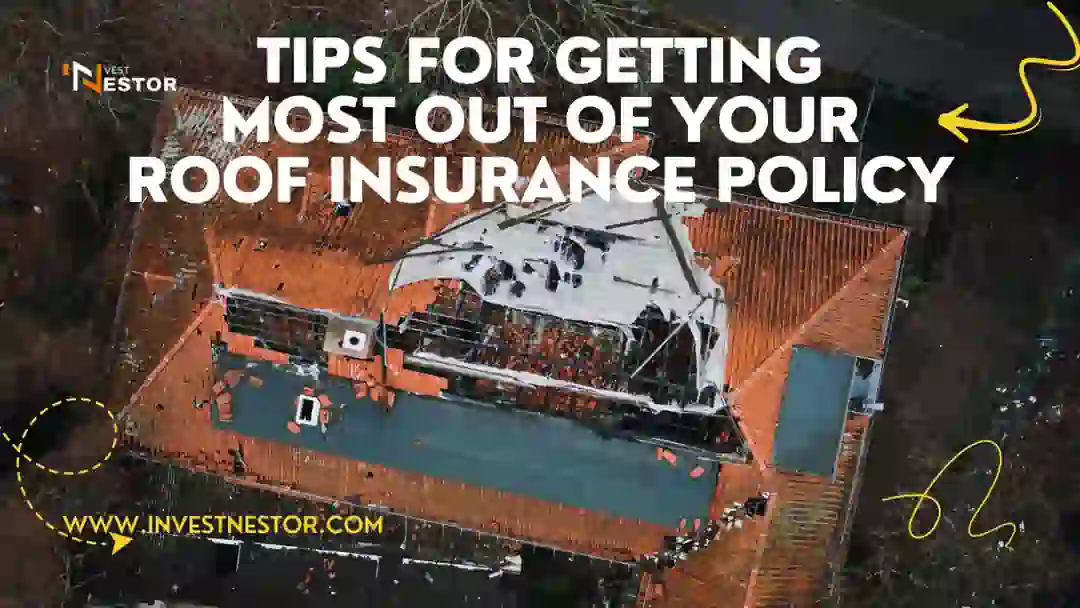
How to File Roof Insurance Claim: Importance of Roof Insurance
We all want a home in good condition. The roof is one of the essential parts of our home that Shields us, so don't you think it's time to protect our roof from unforeseen events like harsh weather and debris from trees? Well, roof insurance is one way to protect your house and, most importantly, the roof, which often can get damaged and put you on the expensive side. Here, you will learn everything about roof insurance claims, roof insurance coverage and the roof insurance claim process. If you think that you need more, we have more for you.
What Is Roof Insurance?
When we opt for a home insurance policy, it also covers a portion called dwelling coverage that protects your home's structure, like roof perils or causes of damage. However, there are some other conditions where your roof may not be covered at all. If your roof is in poor condition or is several years old, in such cases, the insurance company may not provide you coverage for the damaged roof.
Key Highlights
Many homeowners' insurance policies cover replacement if damages are caused by nature or a sudden accidental event.
To claim insurance for your roof damage, you must keep records of preparing before and after photos and reports from inspection and also need to notify your insurance company when damage occurs.
The average replacement cost of a roof is $9,228. However, other factors like size, height, feet, and material can significantly increase or decrease costs.
What Does Roof Insurance Cover?
While taking homeowner's insurance, a policy called HO 3 offers coverage for specific perils. Here is what roof insurance coverage offers
1- Sudden and Unexpected Perils
Roof insurance covers a few damages happening from sudden or unexpected perils. It includes unforeseen events like fire, lightning, windstorms, hail, explosions, civil unrest, aircraft and vehicle damage, smoke, vandalism, volcanic eruption, falling objects, and weight from ice.
2- Specific Incidents
You also get coverage for specific incidents like accidental discharge or overflow of water, sudden failure of water heaters, air conditioning or fire protective systems. It also covers damage caused by freezing and sudden accidental electrical currents.
Here, you must understand that roof insurance covers a replacement depending on the cause of the damage. Incidents like trees falling during a storm are usually covered as they are part of specifically covered perils like wind storms.
How Do You Claim Insurance on the Roof?
Now you know that your homeowner's insurance covers a roof replacement in only certain events. Here is how you can claim the process for roof damage.
-
Prevent Your Roof from Further Damage
If you see that your roof has any damage, you must ensure the situation doesn't worsen. You should prevent your room from further damage by making temporary repairs or hiring help if needed. Your insurance company may pay the expenses you have made to limit the damage.
-
Get the Photos or Videos of the Damage
Photos and videos work as proof that your roof is damaged and you have taken necessary measures in response. Also, note the time and dates when the damage occurred, and write in detail the causes of the damage and also the belongings that were damaged by perils like leaks.
-
Contact Your Insurance Company
Contact your insurance company right away, inform them about the damages and file a claim. Also, ask your insurer about the specific details you must provide for the claim. If you have any doubts about your insurance claim, reach out to your agent and clear all your doubts.
-
Measure the Estimate
Your insurance adjuster will examine the damage and estimate how much repair will cost. You can also consider help from an independent repair estimate by contacting a contractor and asking them to review the roof damage. If your insurance is unwilling to cover a large amount, consider a public adjuster.
-
Complete Your Claim
Fill out any document required to complete your claim and ask your insurer to review everything and approve the claim. You must also know that it may include a deductible in your claim.
Editor Picks: Best Vacant Home Insurance Policy Coverage Options and Benefits
Does Home Insurance Cover Roof Replacement?
There are the best home insurance policies that offer coverage for specific perils. However, you may also need additional insurance to get further coverage for potential risks. There are two notable events, earthquakes and floods, where you need supplemental coverage.
1- Earthquake
Conventional home insurance policies do not cover damages caused by earthquakes; earthquakes can lead to roof damage like shingle displacement or structural shaking. Homeowners in earthquake-prone areas, especially near fault lines, might need additional earthquake insurance.
2- Flooding
Flooding might not be covered under standard Homeowner insurance, while it is also true that flooding might cause damage to the roof and may damage the overall structure of the roof. However, homeowners in flood-prone areas or designated flood plains may be required to have separate flood insurance to prevent themselves from any additional expense.
Does Home Insurance Cover a New Roof?
As far as roof replacement is concerned, a Home insurance policy does not include roof replacement for roofs over 20 years or older. If you have an older roof, in such cases, the insurance company inspects your roof before ensuring your home. It may allow for actual cash value in case of damage that might occur.
It is a significant investment if you want a new roof, and the average cost of replacing a roof is around $9,194. It may go higher depending on the material you choose. If you want to have a roof replacement, then it must fulfil certain conditions, such as widespread damage and your roof being older. Most importantly, the repair cost is close to the cost of a complete replacement.
Suggested Articles: What Are the Top Ten Ways to Lower Your Car Insurance Rates
What Is Extended Replacement Cost Coverage?
Extended replacement cost coverage is the most high-priced, which often guarantees replacement cost coverage. Such endorsement is usually offered for new homes. It typically applies to the entire coverage A/dwelling amount and not just your roof. If you look into it in more detail, extended replacement cost is represented as a percentage like 125% or 150%. It means you have coverage more than your coverage limit. If your home is insured for $100,000 and includes your roof, and you have 125% extended replacement cost coverage, then your actual coverage is $125,000, where $100.000 is not enough for the damage.
There is also guaranteed replacement cost coverage where there is no percentage limit, and in the event of any damage, the insurance company agree to pay the full replacement cost of your coverage regardless of how severe the damage is. For example, you have a policy of $100,000, and in a tornado, you need to rebuild your entire house. Here, the insurance company will pay you the full rebuilding cost even if it exceeds the $100,000 limit.
Here, you must understand that such coverage options are not available to all insurers and all customers. It depends on the age of your home, its condition and the coverage limit that affects your eligibility for such coverage types. Many insurance companies will not offer guaranteed replacement costs on homes because if it exceeds the $1 million dwelling limit, it would be financially burdensome for the insurance company to pay out the guaranteed replacement cost for expensive homes.
What Type of Roof Is the Cheapest to Insure?
If you are looking for insurance-friendly roofing solutions, metal roofers are the most affordable to insure. They are durable and resistant to elemental damage, and they also have insurance experts on staff, which makes them the cheapest option to ensure. Other factors are responsible for determining the insurance cost, like roof shape. Hip roofs with slopes on all sides offer lower insurance premiums because they are less susceptible to wind damage.
Suggested Articles: Understand Universal Life Insurance Cash Value: Types, Benefits
What Is RCV and ACV, and Which Is Better?
Actual cash value roof coverage means your insurance company will pay you for the value of your roof in its current state. Here, depreciation is used to calculate your claim settlement, calculated by a claim adjuster who inspects your roof to determine its replacement cost. He reviews the condition and estimates its remaining life span. Actual cost value coverage is used for older roofs or those in poor condition. It is the least expensive way to cover your roof.
Replacement cost value coverage covers your roof on a replacement basis. The insurance company agrees to pay you what it would cost to replace your roof with a comparable new one. Here again, the claim adjuster estimates the new roofing material, then compares it to what you currently have and offers you a settlement that would cost to replace your roof with these materials. Replacement roof costs are costlier than actual cost value because the detectible would be your only out-of-pocket expense if you have a damaged roof.
Actual cost value is considered better than replacement value only when your personal belongings are relatively new. It is generally cheaper than replacement cost value coverage, which makes it a more affordable option for you; however, it will lead to higher out-of-pocket expenses.
How Do I Know If My Policy Is ACV or RCV?
Your roof coverage has everything to do with the age of your roof and the material you use. The simple concept is to know whether your coverage is actual cost-value coverage or replacement cost-value coverage; then, you only have to know how old your roof is. The older roofs or roofs in poor condition typically have ACV coverage, a less expensive way to cover your roof. Some insurance policies allow you to choose between these two; however, if your roof has passed a certain age, like 15 to 20 years, your insurer will automatically shift you to actual cash value coverage.
Suggested Articles: Accidents Impact on Your Insurance and How to Lower Insurance Cost
Why Does RCV Have Higher Premiums Than ACV Coverage?
You go for replacement cost-value coverage when you want to protect or replace your belongings with a new version of the same items after a severe disaster. Here, you don't need to pay out of pocket, which reduces your expenses after your claim is accepted. However, this raises your premium when compared to the actual cost value, as replacement items may need to be bought before you can get fully reimbursed for your covered claim.
Bottom Line
Purchasing a home is the most important investment of our lives, and caring for it is another step. When it comes to our house, we do everything to protect it from damage, and roof insurance is one such part of it. We often get confused about what to choose between AVC vs RCV roof insurance and what our roof insurance policy will cover. But you don't have to worry because we have detailed it for you, but still, if you have any doubts, remember to ask your insurer!
FAQs
Can I switch to full replacement cost from actual cash value?
It mainly depends on the condition of your roof and its age. If your roof is 15 to 20 years old or in condition, you will automatically shift to actual cash value coverage and may not have the option to choose replacement cost. Similarly, some homeowner insurance policies automatically cover new roofs for replacement costs.
How often do I need to replace my roof?
Generally, a roof only needs replacement after 15 to 20 years if properly maintained. However, it depends on the roofing material. Metal roofs could even last for about 50 to 75 years, and they have been the best roof material till now. However, for insurance purposes, you must maintain your roof properly and consider a roof inspector to know its condition.
Does the roof insurance cover roof leaks?
If your roof leaks due to damage from a covered peril, your insurer might pay to repair or replace it. Still, it will limit your coverage and also deduct your deductibles. If your roof damage results from negligence or wear and tear, your insurer won't cover it.
Suggested Articles:






0 Comments
Add a comment